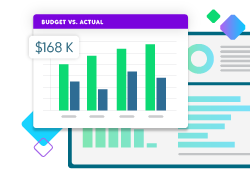How Nonprofit Accounting is Different from Small Business Accounting

Accounting is an essential part of any ongoing enterprise. It is the meticulous process of recording and organizing financial transactions and is the backbone of the financial system for both nonprofit organizations and small businesses. And while the fundamental principles of accounting remain constant across different entities, the way those entities approach accounting varies a lot based on the nature of their organization.
Every company in existence, large or small, for-profit or nonprofit, must keep track of their transactional financial activity. It’s not an option. And while many aspects are the same between charitable entities and commercial businesses, other elements are quite different indeed, down to their very reason for existing. A nonprofit organization exists to fulfill a specific mission or purpose rather than earn a profit, while a small business usually has profit maximization as its primary goal.
In this article, you will learn about the nuances of fund accounting, including the key differences between what nonprofits need and what small businesses need, and the rationale for those differences.
Fund Accounting vs. Single Accounting System
Nonprofit organizations typically use a fund accounting system, which segregates financial resources into separate funds, each dedicated to specific purposes or programs. This separation allows nonprofits to track the financial performance and accountability of each fund independently. Common funds in nonprofit accounting include the general fund, program funds, and restricted funds, each serving distinct objectives.
Imagine a nonprofit organization dedicated to improving education in underprivileged communities. They might have multiple funds, such as the “Scholarship Fund” to support students’ education expenses and the “Community Outreach Fund” for community engagement initiatives. By segmenting funds, the organization can ensure that donations and grants received for scholarships are used exclusively for that purpose, maintaining transparency and accountability.
By contrast, small businesses typically use a single accounting system to record all financial transactions, regardless of their purpose. Unlike nonprofit fund accounting, there is usually no need to separate funds for different purposes, as the primary goal of a small business is to generate profits for its owners or shareholders.
Consider a local ice cream shop. All the income generated from selling cones, shakes, and sundaes is recorded in a single accounting system. There is no segregation of funds based on specific activities or goals because the primary aim is to ensure the business remains profitable. Also, no customer is going to request a report showing the money they paid for their banana split only went to buy more bananas, so it doesn’t need to be tracked separately.
Revenue Recognition
Revenue recognition is more nuanced for nonprofits than it is for small businesses. Nonprofit revenue is typically made up of one or more of the following: donations and grants, program fees (revenue generated from regular sales of goods and/or services, the sale of which directly furthers the exempt purpose of the organization), and/or investment income.
Nonprofits categorize donations and/or grant income as either “with donor restrictions” or “without donor restrictions.” This distinction is essential because certain funds can only be used for specific purposes as designated by the donor. Recognizing these differences ensures that funds are used appropriately and transparently.
Timing of revenue recognition can be unusual for nonprofits, as well. Nonprofits typically recognize revenue when it is earned and realizable, which can be different from when cash is received. An example of this concerns pledges received. If a pledge is uncertain, revenue is usually recognized when the gift is ultimately received. If a pledge is certain and irrevocable, revenue is recognized in the period the pledge is made by the donor, not when the promised gift is received.
Another nonprofit nuance involves multi-year grants. This can result in delayed revenue recognition, depending upon the grant requirements.
If a nonprofit organization receives a multi-year grant to support a three-year educational program, the revenue is recognized over the program’s duration. This concept is known as the matching principle. In this case, revenue recognition is tied to the program’s performance, even though the entire grant amount may have been received upfront.
For a small business, revenue is recognized when a product is sold, or a service is rendered. For example, when a customer buys a product, the transaction is recorded as revenue for the business. That can look different depending on whether the organization uses the accrual or cash method of accounting. But there is no small business version of restricted revenue or pledge accounting.
Financial Statements and Reporting
A small business, like most other commercial entity, has specific financial statements that are fundamental to its accounting, those being: the Income Statement (or Profit and Loss Statement), the Balance Sheet, and the Statement of Cash Flows.
Nonprofit fund accounting generates similar reports, but with important distinctions, including the naming convention. For example:
- The Income Statement is referred to as the “Statement of Activities.”
- The Balance Sheet is referred to as the “Statement of Financial Position.”
- Instead of an equity section on the Statement of Financial Position (Balance Sheet), nonprofits have “net assets,” which are further categorized based on donor restrictions.
- The Cash Flow Statement is similar but might have specific line items related to donations or grants.
A nonprofit’s Statement of Activities would also show the various sources of revenue, such as grants, donations, and program fees, as well as the corresponding expenses associated with each program or fund. This level of detail is essential for transparency and accountability in nonprofit organizations.
Profits vs. Surpluses
Small businesses aim to generate profits, which can be reinvested into the business or distributed to owners and shareholders. Profit is why the owner is in business to begin with. And the larger the business, the more important this is. Publicly traded companies are required by law to consider profit-maximization as a key mandate.
When a nonprofit has more revenue than expenses, it results in a surplus, not a profit. This surplus is typically reinvested into the organization to further its mission. Unlike commercial businesses, nonprofits do not have shareholders or owners to distribute profits to.
Challenges Faced by Accountants and Bookkeepers Working with Nonprofits
Working with nonprofit organizations presents unique challenges for accountants and bookkeepers. These challenges stem from the complexities of nonprofit fund accounting and the need to adhere to strict regulations and reporting standards. Some of the key challenges they face include:
- Understanding Nonprofit Regulations: Accountants and bookkeepers must have a thorough understanding of nonprofit regulations and accounting standards, including the Financial Accounting Standards Board (FASB) guidelines specific to nonprofits. Staying up to date with changes in regulations is crucial to ensure compliance because these standards are regularly reviewed and revised.
- Tracking and Reporting Restricted Funds: Nonprofits that receive funds with donor-imposed restrictions must meticulously track and report on these restricted funds to ensure compliance with donors’ wishes. This involves creating separate accounting entries and financial reports for each restricted fund.
- Complex Revenue Recognition: As mentioned above, nonprofits often rely on grants, which can have complex stipulations about the timing and conditions for revenue recognition. Accountants must carefully match revenue recognition with the performance of programs or projects to avoid misreporting.
- Grant Management: Managing grants from various sources requires an elevated level of organization and attention to detail. Accountants must ensure that grant funds are used in accordance with grant agreements, and accurate records of grant expenditures must be maintained.
Nonprofits Need Nonprofit Accounting Software
Accounting for nonprofits is simply not the same as it is for small business. The overall health and success of both organizational types depend heavily on timely and accurate financial records.
While the foundational principles of financial recordkeeping apply universally, the methodologies and key requirements differ when comparing nonprofit fund accounting and small business accounting. Understanding these differences is essential for anyone involved in financial operations or oversight within these entities.
To learn more about why nonprofits shouldn’t settle for commercial accounting software, check out our webinar, Why Nonprofit Accounting is Different Than Accounting for Business.
Fund Accounting Software that Drives Impact
Find out how Blackbaud’s Financial Edge NXT® fits your organization.




